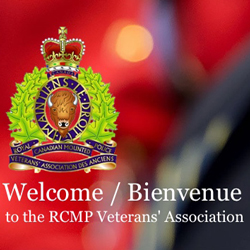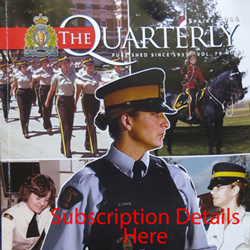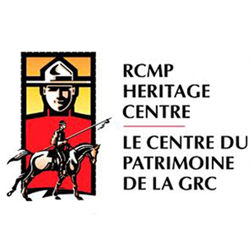Supt. Severe Gagnon
Severe Gagnon was one of the first French-Canadians recruited to the North-West Mounted Police.
Being a bilingual officer, he was transferred to Fort Carleton as the Post Commander – to provide intelligence reports on the activities of Metis unrest. His report provided a means of identifying the various complaints of the Metis people and intelligence on the activities of Louis Riel’s subversive activities.
Early Years
Severe Gagnon was born on January 8, 1845 at Berthierville, D’Autray Quebec. Prior to 1873, Severe studied at St. Mary’s College and graduated with a Law Degree. Before joining the Force, he was a lawyer at the Joseph Doutra law firm in Montreal.
Joins The Force
With the establishment of the North-West Mounted Police, several French-Canadians were recruited as officers in the Force. These individuals included: Theodore Richer, Joseph Forget, Charles Nicholle, E. Frechette and Severe Gagnon.
Severe Gagnon was sworn in on April 3, 1874 and commissioned to the rank of Sub-Inspector (Reg. # O.20). For the famous March West, he was assigned as the 2nd officer of “A” Troop under the Command of Inspector William Jarvis (Reg. O.2) and Sam Steele was the Troop Sergeant Major.
March West
The progress of the March West was not proceeding as quickly as expected. This slow progress was attributed to cattle, wagons and sick horses. At a meeting of the officers, Inspector Jarvis volunteered “A” Troop to divert the “55 horses, twenty-four wagons, fifty-five carts, sixty-two oxen, fifty cows and calves and twelve Metis drivers”[1] to Fort Edmonton. With the approval of Commissioner George French, “A” Troop split off from the main body at Roche Percee (400 miles west of Winnipeg). Under Commissioner French, the main body of the Force headed to Fort Whoop-Up.
After 88 days and traveling 900 miles from Roche Percee, “A” Troop arrived at Fort Saskatchewan. While on this March West, he kept a diary of their daily activities. His diary can be read on the Library Archives of Canada website – http://www.lac-bac.gc.ca/nwmp-pcno/025003-1200.1-e.html
One of Severe Gagnon’s diary entries states:
“On Sunday 12 July, the anniversary of the Battle of the Boyne a start was made at 5 a.m. The French-Canadian sub-inspector Severe Gagnon, who sported a full beard almost to his waist and managed to balance his forage cap over the right ear without benefit of a chinstrap, noted drily in his diary:’Orangemen Day. They are easily noticed, for they are all displaying yellow flowers on their hats or on the heads of their horses.”[2]
After arriving at Fort Edmonton, members of “A” Troop were involved in the construction of Fort Saskatchewan in 1875.
Swift Runner Investigation
In 1879, the Cree Indians outside Fort Saskatchewan reported to the NWMP of the suspicious activities of a Cree Indian called Swift Runner (Ka-Ki-Si-Kutchin) (born 1839). It was suspected he had killed and eaten his mother, brother, wife and six children. Swift Runner originally claimed that his family starved to death. Based on these reports, Insp. Severe Gagnon lead a party of NWMP members with Swift Runner to the crime scene. When they arrived, the skeleton remains of his family were found and human flesh was found in one of the cooking pots. At first, Swift Runner denied all involvement. However, when he was given some liquor, his memory of the event returned and admitted to killing and eating his family.
On August 6, 1879, the Judge and Jury trial commenced at Fort Saskatchewan where Swift Runner plead guilty and was sentenced to be hung. The preparations for the construction of the gallows was undertaken by Staff Sergeant Fred Bagley (Reg. # 247).
The execution order was upheld by the Canadian Justice Department and the execution proceeded on December 20, 1879 at Fort Saskatchewan. When it came time to escort Swift Runner to the gallows – this task was undertaken by Inspector Severe Gagnon and Sheriff Edouard Richard .
This story of murder and cannibalism was widely reported as being the first person being convicted of such crimes and the first person to be executed in the North West Territories. In addition, Swift Runner was also the first person to be hung at a Force establishment.
The newspapers of the day failed to include in their articles that Swift Runner was originally employed by the NWMP as a guide in 1875 and was previously employed with the Hudson’s Bay Company. A NWMP member described this striking 6 foot 3 inch with native as a strapping build as “ugly and evil-looking a face as I have ever seen.”
If you are interesting in learning more about the Swift Runner story, you are encouraged to read the book entitled “Swift Runner” by Colin A. Thomson.
General Duties
In 1879, Superintended Jarvis and Inspector Gagnon were responsible for Northern Saskatchewan and they “had their hands full looking after about 3,000 Indians scattered between Edmonton, Victoria, White Fish Lake, Lac LaBiche and Battle River”[3] which included issuing Indian treaty payments.
On November 17, 1880, Commissioner Acheson Irvine (Reg. # O.30) wrote to the Minister of the Interior and provided a comment on Inspector Gagnon by stating “I have seen very little of this officer. He appears to have performed his duties satisfactory at Edmonton. He is a lawyer. Doubtless I shall soon be in a position to judge of this officers’s ability and usefulness, if so, I shall lose no time in forwarding a more detailed report.”[4]
On July 7, 1883, Severe Gagnon was promoted to the rank of Superintendent and his salary was set at $1,400 per year.
North-West Rebellion
In 1884, Superintendent Severe Gagnon was transfer to “E” Division (Calgary). With concerns being raised about the unrest in the Metis communities in Northern Saskatchewan, Fred White (Comptroller for the NWMP) recommended in October 1884 that a new NWMP Fort be established at Fort Carleton. “Supt. Severe Gagnon was placed in charge with a small detachment from Battleford and for the time being the medical headquarters of “D” Division.”[5]
According to Sam Steele, Supt. Gagnon “had been placed in command of the force at Carlton on account of his knowledge of the French language and long experience, reported that the half-breeds of St. Laurent and Batoche had held a public meeting to adopt a petition which had been duly forwarded to Ottawa, and that Riel was pressed to remain amongst them and had been presented with a house and would be given a purse next month.”[6]
With his linguistic abilities, he was able to provide timely intelligence on the activities of the rebel group and the progress of the NWMP engagements with the rebels. For example, on March 1885, Gagnon telegraphed out the message that “the half-breeds were excited and moving about more than usual and that they proposed to prevent supplies going in after the 16th.” Another example was a telegraph to the Commissioner which stated “Crozier exchanged shots with rebels at Duck Lake; 6 men reported shot, Crozier retreating on Carleton. Everything quiet here, but ready for an emergency”[7] evacuation.
When questioned on what were the primary concerns were by the Metis – “Gagnon was quit right when he stated later that the main cause of the discontent amongst the half-breeds was the introduction by the Government of the rectangular survey of land on the prairie. Under this system settlers had to hold their farms in square blocks of 160 acres or more and in consequences such settlers would be necessarily some distance apart. This was not to the mind of the half-breeds, who were more given to social gatherings than to agriculture, and who preferred the old survey that they knew on the Red River and the Assiniboine, where their holdings were in narrow strips fronting on the river and running two miles back. To introduce this on the prairie, the Government contended, would lead to confusion, and so it was easy for the agitator to stir up discontent amongst these inflammable people who had always been accustomed to the freedom of the plains.”[8]
After the end of the rebellion, Severe Gagnon was transferred to Regina in 1886 to take command of Regina and Depot. He was the type of Officer who contributed to the training at Depot such as instructing new recruits in “their policing duties as NWMP members.”[9]
Transferred to Depot
While being stationed at Regina, he met and married Emma Royal on November 28, 1888. Her father was at the time was the Lieutenant-Governor Joseph Royal for the North West Territories.
In June 1889, the “Lieutenant-Governor Royal accompanied Supt. Severe Gagnon on a visit to Fort Battleford and inspected the barracks which he found to his entire satisfaction.”[10] “Royal was an experienced westerner; lawyer, publisher, cabinet minister in the province of Manitoba from 1872 to 1879 and MP from that province from 1870 to 1888 and had also served on the first NWT Council.”[11]
Royal was probably told of how difficult and unpopular it was for the NWMP to enforce the liquor prohibition in the North West Territories. On July 23, 1888, Royal decided to permit a limited amount of liquor into the North West Territories by a special permit. In an effort to provide inexpensive liquor to members of the Force, the Commissioner approved the importing of 100 gallons of brew each week from Winnipeg to be consumed by the 170 members stationed in Regina. Other Divisions were also permitted to order various quantities of liquor for their members. All liquor was only to be consumed in the respective Division Mess.
Severe Gagnon remained in Regina as the Commanding Officer of Depot until February 15, 1895 at which time he was transferred to Prince Albert.
Almighty Voice Incident
With the sudden murder of Sergeant Colebrook (Reg. #605) by Almighty Voice, Supt. Gagnon delegated members to conduct enquires on the location of Almighty Voice. Almighty Voice was able to avoid detection and apprehension until May 26, 1897.
As a result of this member’s death, Supt. Gagnon coordinated the formation of an apprehension force which consisted of 100 NWMP members and civilians. Insp. Wilson came across Almighty Voice at Minichnas Hills. For two days, the fugitives exchanged gunfire and resulted in the death of Corporal Charles Hockin (Reg. #3106), Constable John Kerr (Reg. #3040) of the NWMP and Ernest Grundy, Duck Lake postmaster.
With the fugitives having the advantage of being on a bluff and shooting down at the members, Supt. Gagnon ordered in one 7 and one 9 pounder cannons.
On May 30, 1897, the cannon bombardment began and lasted for two hours. With no gunfire coming from the fugitives, the NWMP members approached the bluff and the found Almighty Voice, his brother-in-law Topean and his cousin Little Saulteaux all dead from the cannon bombardment.
A historically correct video of the cannon bombardment and death of Almighty Voice and his two companions is found at – http://www.youtube.com/watch?v=f2RChKvbFRA
Recently, the CBC did a program about the life and death of Almighty Voice. Check it at – http://archives.cbc.ca/society/crime_justice/clips/12547/
A few years later, Supt. Gagnon came down with a serious illness which escalated to the point that he was granted extended sick leave and eventually retired on March 31, 1901. Severe Gagnon eventually passed away of his illness on May 9, 1909 while living in Montreal. This original NWMP member was laid to rest in Montreal at Notre Dame des Neiges Cemetery concession 00260 SEC B.
Severe Gagnon’s only son (Henri Albert Royal Gagnon – Reg. #O.213) followed in his father’s footsteps and also joined the Force on February 1, 1920. Henri retired on November 19, 1947 at the rank of Deputy Commissioner. He passed away while in the Force on 19 November 1947 and is buried beside his father – Superintendent Severe Gagnon.
[1] MacEwan Grant – “Colonel James Walker: Man of the Western Frontier.” Saskatoon: Western Producer Prairie Books – 1989 (page 49)
[2] Atkin, Ronald – “Maintain the Right:The Early History of the North-West Mounted Police.” Toronto: MacMillan Company of Canada – 1973 (page 62)
[3] Turner, John Peter – “The North-West Mounted Police” Volume I. Ottawa: King’s Printers (1950) (page 487)
[4] Library Archives of Canada: NWMP Personal Files – Supt. Severe Gagnon.
[5] Turner, John Peter – “The North-West Mounted Police” Volume II Ottawa: King’s Printers (1950) (page 82)
[6] Steele, Sam B. – “Forty Years in Canada: Reminiscences of the Great North-West.” New York: Dodd, Mead & Company (1915) (page 201)
[7] Steele, Sam B. – “Forty Years in Canada: Reminiscences of the Great North-West.” New York: Dodd, Mead & Company (1915) (page 202)
[8] Macbeth, R.G. – “Policing The Plains:Being Real-Life Record of the Famous Royal North-West Mounted Police.” New York: Goerge H. Doran Company (page 107)
[9] Turner, John Peter – “The North-West Mounted Police” Volume II Ottawa: King’s Printers (1950) (page 317)
[10] Turner, John Peter – “The North-West Mounted Police” Volume II Ottawa: King’s Printers (1950) (page 436)
[11] Beahen, William and Horral, Stan – “Red Coats on the Prairies: The North-West Mounted Police 1886 – 1900.” Regina: Print West Publishing Services (1998) (page 32)


 January 19, 2012
January 19, 2012 












